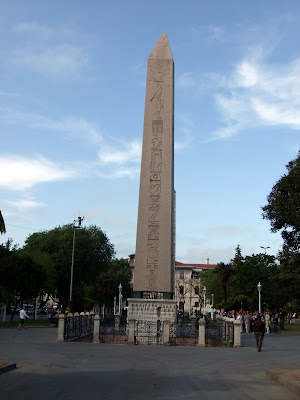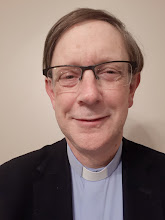As the Istanbul metro was not working when I arrived, and the train station was not far from the Sultanahmet area in which my hotel was, I walked up the hill to Sultanahmet. There is a lot of tourist accommodation in Sultanahmet, because so many of the key sites are in this area – the great cathedral of Hagia Sophia, which was converted into a mosque and is now a museum, the Basilica Cistern, the Blue Mosque, the hippodrome and the Topkapi Palace, to name just the main ones.
I got to the hotel after asking for directions a few times, and was given a hospitable welcome and a very adequate room with a double bed. Luxury! I decided that I would take the day fairly easily, so I did a few chores, spent some time on the computer, and then had a sleep. In the evening I had arranged to have dinner with Nancy Woodburn, a course member from the Bible and its Setting course, and her daughter Anna, who were in Turkey. This was their final night in the country. We had a lovely evening and a delicious meal together.
The next day I set off early for Hagia Sophia, the cathedral of Constantinople during the time of the Roman Empire in the East, until Constantinople was captured by the Turks and it was turned into a mosque (hence the four minarets). This Church was built by the Emperor Justinian in the sixth century AD, and for 1,000 years was the largest building in the world.
It is an awesome and remarkable building, with the beautiful dome sitting majestically above it. In fact, with the windows shedding light into the dome, the dome almost seems to hover over the building rather than to weigh down upon it.
Apparently it was the flexible resin in the mortar between the stones that has kept the dome intact through countless earthquakes over 15 centuries.
When Constantinople was taken by the Turks in 1452, they immediately converted Hagia Sophia into a mosque. But in 1932, on the recommendation of Kemal Ataturk, it ceased to be a place of worship and was officially designated as a museum, thereby making it more accessible to Christians. Elements sacred to both Muslim and Christian worshippers have been retained.
In the photo above you can see quotations from the Qur’an in Arabic script and the mihrab (niche that points to Mecca) in the apse – the former Christian sanctuary. Just under the dome you can also see depictions of the six-winged seraphs (in one of these the face has now been revealed - it was formerly plastered over in keeping with Islamic prohibitions on the depiction of creatures).
The Turks are now renovating the building, and more and more of the Christian elements that had been painted or plastered over are being revealed. Chief among these are some beautiful mosaics. From the left, this mosaic depicts the Virgin Mary (Theotokos), Jesus Christ, and John the Baptist (the Forerunner).
The beauty of these mosaics can be seen even more clearly ‘close up’.
And I thought the expression on the face of John the Forerunner (John the Baptist) was particularly beautiful.
It is probably revealingly partisan of me, but I have something to admit here. While acknowledging the generous spirit of Ataturk in converting this from a mosque to a museum, and while greatly enjoying my visit to Hagia Sophia, I still felt a pang of sadness that this majestic expression of Christian faith had been put to other uses than the purpose of Christian worship for which it was originally intended.
After a break I went to the underground ‘Basilica Cistern’, which despite the name is not particularly associated with Hagia Sophia. It was built in the reign of Justinian to hold water for the city, and to store it in case of siege or drought. The water was brought by aqueduct to the city from a water source 19kms away. The cistern is huge – 140 metres long by 70 metres wide, thus covering a total area of 9,800 square metres. The 336 marble columns of the cistern are 9 metres high.
The cistern is partially lit so that people can get some idea of its size.
Following this visit I headed off to the Blue Mosque, which had been built in the 15th century AD, after the capture of Constantinople. This was a beautiful building with amazing tile work and lovely stained glass windows.
I made my way home via the old Constantinople hippodrome. This has been converted into a promenade, but still retains a few important monuments from imperial times. The first one is partly broken, but highly significant for anyone like me who has studied classical Greek. It is a column formed by 3 intertwined bronze serpents and dedicated to Apollo by the 31 city states who defeated the Persians in the battle of Plataea in 480BC. This victory was an incredibly important ‘coming of age’ for the ancient Greeks. It brought in the great flowering of the classical period in Athens, with its buildings, sculpture and art, drama, poetry, historical and other writing, and so on. I was amazed to see the monument, because I didn’t know that it still existed.
The second monument is an obelisk from the time of Egyptian Pharoah Tuthmose III (1479-1426BC). It was brought to Constantinople in the reign of Theodosius in the late fourth century and erected in this place, but it is in such a fine state of preservation that it looks as if it was sculpted in the last few years.
After all this sightseeing, it was time for a break, so I took it easy for the rest of the day.
The next day I was up early again for a day of museum visiting. I headed off for the Topkapi Palace, which had been the residence of the Turkish Sultans, along with their harem and entourage.
The Palace was magnificent, with beautiful buildings, and outstanding collections of jewellery and other precious things. Again, a few photos will have to suffice to give you some idea. No photos were allowed in the Treasury areas, so if you are interested, take a look on Google for some of the treasures of the Topkapi palace. They are amazing!
I went first to the harem and private rooms of the Sultan. The rooms of the Queen Mother in the harem were very impressive. The Ottoman decoration is from the 17th century and the Western influences are from the 19th century.
The Imperial Hall served both as the Sultan’s official reception area and as the entertainment hall for the harem.
The private rooms of Sultan Murad III, built by the famous architect Sinan in 1578, are considered among the finest examples of Ottoman architecture.
The apartments of the Crown Prince were also gorgeous, with the beautiful stained glass windows being complemented by matching tiles.
and so it went on. One room surpassed another in beauty, and one treasure outshone the previous one in opulence. There was also a magnificent view over the Bosphorus from the palace.
Along with the huge number of Topkapi treasures, there was a beautiful visiting exhibition on display – 5,000 years of Japanese Art. No photos were allowed at this exhibition, but very memorable amongst the items in the Japanese collection were two beautiful early Buddhist statues (one of lacquered wood, one of stone) depicting human figures in an attitude of prayer. They communicated in a wonderful way a spirit of serenity and inner peace.
After the Topkapi Palace I went to the Archaeology Museums close by. I had been told that they were good, but I was not prepared for how wonderful they were. They were amazing – with exhibitions of beautiful sarcophagi, grave stones and artefacts from Greek, Hittite and other Anatolian civilisations, exhibitions from Egypt, Cyprus, Troy, the Byzantine Empire, and so on. Unfortunately my camera battery ran out along the way, so some of the most impressive ancient Anatolian and Egyptian items I didn’t record.
The exhibitions started with sarcophagi from a royal necropolis (cemetery) in Sidon (modern Lebanon) found in the late 19th century. This sarcophagus dates from the 4th century BC.
Here is some of it as it would have looked before the original paint peeled off.
There were many grand and beautiful sarcophagi, but also more touching and personal monuments to the dead. I thought the following wording was moving: “Philippos has erected this stele for his wife Tryphaine, who was his heart’s content.” And another stele caught my attention too.
It reads, “His owner has buried the dog Parthenope that he played with, in gratitude for this happiness. [Mutual] love is rewarding, like the one for this dog. Having been a friend to my owner, I have deserved this grave.”
The exhibitions certainly weren’t by any means all focused on death. This beautiful pottery was made in Cyprus between 1050 and 750BC.
And there were other remarkable exhibits. I took almost 8 hours looking at the exhibitions at the Topkapi Museum and Archaeology Museums, and if I had had an extra day in Istanbul I might even have gone back to the Archaeology Museums to photograph more of the Sumerian, Assyrian and Egyptian a
rtefacts. If you get the chance to go, don’t miss them – and take a spare camera battery!






















1 comment:
Great info.
Great shots.
Great Sharing.
Thanks...
Post a Comment